 |
Artist Journal - Photosynthesis - biotic imprinting on the leaves of Bromeliad plants - © Lloyd Godman
experiments
Artist
Journal - Lloyd Godman
Since 1989 my work had moved away from taking photographs to exploring photosensitivity with photograms. In 1995-6 I realized that plants are actually a form of photography, they use light in the same way as film. I decided to experiment with plants as a form of image making - in a sense SLOW ART! |
|
For more than a decade I had been intrigued by the technologically simple
and environmentally sensitive practice of artists like Andy Goldsworthy,
Hamish Fulton and Richard Long, and although they do not use light as
part of the process to make images, some works, like Goldsworthy's colour
spectrum forest leaf arrangements, provide a poignant response to nature's
photo reactions. During this time I had also become aware of artists incorporating
living plants in their art activity. Activities like Joseph Beuys "7,000
oaks" project in Germany, Ian Hunter's willow to charcoal to willow
project in England, Angie Denes "Wheat Field in Manhattan Dump"
and Gustav Mahler's "Earth, Poplars, Grass", demonstrated the
direct relationship plants can play in contemporary art practice while
contributing positive benefits to the environment the works make comment
on. |
|
Some
of Goldsworthy's works, where he lies on the dry ground during a passing
rain or snow shower and later photographs the marks his body has left
on the dry area of earth provided the impetus for the hypothesis for my
present work proposal. I was engaged by the idea that a simple natural
phenomenon could leave such telling yet ephemeral marks on `nature'. I was fortunate to meet Goldsworthy in New Zealand and attend a talk he gave.
From
here I began focusing on another natural phenomenon that has been central
to my earlier work; light. I began considering the essentiality of light
to all life forms on the planet, considering how light reacts in the natural
environment through photosynthesis, considering the intermediary part
plants play in transferring this energy to usable substances other life
forms can access , and considering how this process could be explored
in my art practice. |
|
During this time I had also expanded my interest in collecting Bromeliads
, (a family of epiphytic plants from South America). I began researching
the biotic strategies of these plants, particularly the leaf and inflorescence
colour change at flowering, the efficient epiphytic system of water and
nutrient gathering and retention, and the relationship of these plants
to their ecosystem system.
I
concluded that while they provided a suitable living emulsion to investigate
the image-forming potential through photosynthesis they also provided
a conceptual model to juxtapose epiphytic and parasitic behaviors of various
species on the planet. |

Bromeliads grow on the wall of the entrance to my house in Brighton. 1990s |
As I began work on the project, it became apparent that the process of
forming images on the leaves through photosynthesis is incredibly slow,
time-consuming and uncertain. (It can take up to several months to form
an image while on some plants images of any kind are difficult to attain).
Also there was the added complication that the collection of plants requires
daily attention and care. While staying in touch with contemporary theory
and practice, it became obvious that I had to devote disproportionate
research time to biology, botany and horticulture if the project was to
succeed.
I began by simply placing a small piece of insulation tape on the leaf, leaving the plant in the light for a few months and then when I removed the tape a change in the pigmentation of the leaf revealed itself.
During
this exploration, I became aware of the work by English artists Heather
Ackoryd and Dan Harvey, where they project UV light onto sprouting grass
seed to produce images. I have since corresponded with them about the
similarity of our work and in reply, they mentioned that while they had
considered the photogram technique, they had never found time to implement
it, and wished me well with the project. |
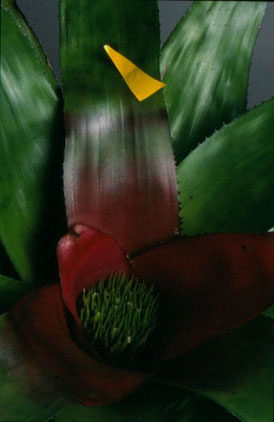
Bromeliad with
Yellow insulation tape in place 1996 |
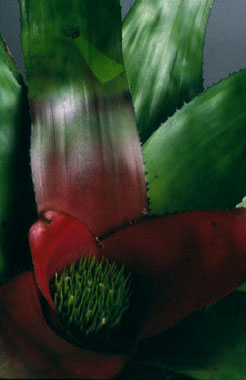
The same plant
with the tape removed after 3 months |
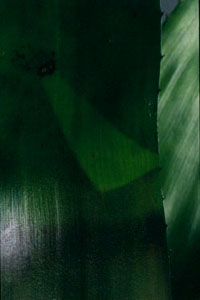
Detail |
|
|
| This can happen in nature where a leaf might get stuck onto another leaf and create a colour change. Mouse over the image on the right to view. |
 |
During
the the initial phase of the project, I also investigated two other potentials
using the expanding plant collection. The first was the use of the collection of
bromeliads to explore the visual incongruity between the in/organic when
they were installed in various unfamiliar locations like industrial sites
and museum cases.
The second
was the idea of connecting the plants to sensitive electronic devices
to record their response to the a changing environment around them and
in turn use this response to drive other electrical devices within a gallery
context. While his aspect of the work is still under exploration and some
progress has been made, it has not progressed enough at the present time. |
 |
Electromagnetic
radiation (Light) is essential to sustaining life on the planet Earth,
and the ability of plants to photosynthesize is a crucial factor in the
transference of this energy. Archimedes 287?B.C.
212 first noted aspects of the pigmentation change in plant tissue due
to exposure to sunlight and since then photosynthesis has been central
to much speculative and scientific investigation.
But
light is also central to sight, and as such is as essential to the visual
arts as it is to the life process. As far back as prehistoric times, the
power of light from the sun was recognized and became an integral part
of ritual and image culture, became a central icon that crossed generations
and race, became the centre of myth and religion and became the centre
of life. The Greeks, Empedocles, Leucippus and Democritus were among the
first to contribute documented theories on light, and the fascination
to explain the phenomenon and its meaning have continued for centuries. |
|
Until
the 1920s, many artists produced representations of light, but from the
1920s there was a distinct difference: Man Ray, Moholy Nagy, El Lissitzky,
Len Lye and others initiated contemporary investigations into light itself
as a valid medium for art making, an investigation which has continued
in various forms through the century to the present day by artists like
Ralph Hotere, Christian Boltanski.
My
interest in the theme for this project came from the conceptual amalgamation
of two long held personal activities that employ light:
*the
process of growing plants (which I had engaged in since 1973, but previously
only as a botanical endeavor)
*and that of photography. (Which has been central to my work since 1974) |
|
As part a beginning point of my MFA I engaged in exploring these photosynthetic images. However my supervisor was very unsympathetic and strong suggested I move away from this work and explore installations and light.
I did move from creating these ephemeral photosynthetic images and concluded the MFA with the enLIGHTen project, but I consider the idea still has huge potential and intend to explore it further at some point. |
|

Detail
showing hand cut foil masks on the leaves of a Bromeliad plant 1996
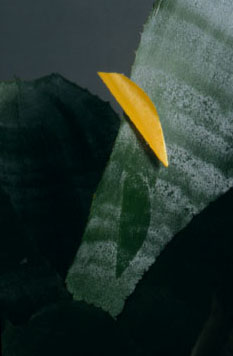
Bromeliad
have a scale on their leaves called trichomes, and on some
species like this Billbergia the tichomes produces a thick
silver layer on the surface of the leaf. The trichome cells
open up when they are wet and allow water to pass into the
leaf structure. As it drys out, they close down again and
lock the water in. On some plants the trichome forms as a
visible banding on the leaf. During the taping experiments
this layer would often pull off with the tape.
Effect
of Tape mask on plant with trichome banding 1996
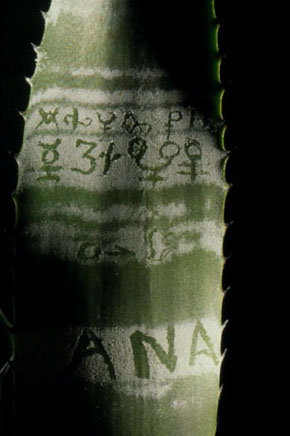
Experiments
with scratching through the trichome layer with alchemic
symbols 1996
|
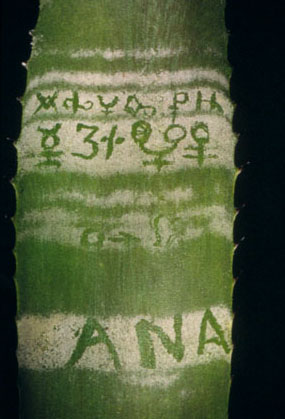
|
Bromeliad
have a scale on their leaves called tichomes, and on some
species like this Billbergia the tichomes produces a thick
silver layer on the surface of the leaf. The trichome cells
open up when they are wet and allow water to pass into the
leaf structure. As it drys out, they close down again and
lock the water in. On some plants the trichome forms as a
visible banding on the leaf. During the taping experiments
this layer would often pull off with the tape.
Effect
of Tape mask on plant with trichome banding 1996
Alchemy
Alchemic
symbols
Masking
experiments - Feed
back
Hi Lloyd,
my name is Laura Wills I'm a visual artist based in Adelaide
, currently on residency at Laughing waters in Eltham, Victoria.
I was at the talk you guys gave about the
Bodissian Press Studios at the RED Chair artist talks last month.
And have since had a look at your website, great work.
I'm doing some research into artists who work with plants and photosynthesis-
in a way of using light to control the colour (greeness) of plants/ grass for "drawings"/ works,
I am interested to learn more about this and wondering if you have seen other artists working with these techniques ?
I'm not finding much from google.
i,ve grown words before , and would like to do s thing more elaborate and am interested to view what has been done in this realm.
If your interested some examples of my drawing works on found maps can be seen here ,
http://www.hillsmithgallery.com.au/stockroom/wills_laura_works.html
http://www.artroom5.com.au/Exhibition5/Wills.html
looking forward to hearing from you ,
cheers,
Laura
Hello Laura
Thanks for the email and interest in my work - and great you are interested in plants -
2 artist who do a great deal of work in this area are Heather Ackroyd and Dan Harvey from England, they work with grass to grow images via photosyn- so check them out - I have written to them and also met them years ago - Nice people.
over the past few years they have been working with GM grass that keeps its pigment when it dies - this is so the works are less ephemeral - However GMs not really my area.
Some plants like grass are quite easy to work with and the reaction is relatively quick. I have done a couple of works with grass
- http://lloydgodman.net/planetII/express.htm
I also did some work with plants growing as time lapse - one at MOCA Ga in Atlanta
http://lloydgodman.net/Time/Time7.htm
the photosynthesis work I have done is with Bromeliad plants - I began this about 1996 as part of my MFA, but my supervisors directed me away from the work into other areas that cumulated with light projections and suspended plants
http://lloydgodman.net/Photosynthesis/PHoToS/enlight/enlightA.htm
- although Bromeliads are more difficult to work within terms of photosynthesis, there are many reasons I work with these plants - one they are largely epiphytes and a like the play of the epiphyte against our parasitic behavior on the planet - from this I did a work titled Plant Room
http://lloydgodman.net/Photosynthesis/PHoToS/Boil/index.htm
they also reverse the day night CO2 cycle, which is appealing, and are xerophytes, which means they live on little water and have evolved a unique means of water absorption and retention. You have to take on plant biology to understand this stuff.
With genus like Neoregelia and Aechmea I grew a series of alchemical symbols and other motifs that referenced the consumer society into the bromeliad plant tissue - this took 4 months or more to achieve a noticeable mark, the method was a lot more complex than grass, needed years of experimentation and the results were far less predictable. About 2004 I had to sell all my plants in NZ to move to St Andrews and I am now in the process of building up my collection again. In fact I now know how to pollinate them and grow them from seed, an even longer process of up to 7 years but a very rewarding one, so I have 1,000s of new hybrids, which as yet have not revealed their pigmented secrets. From here I am aiming to experiment more with this photosynthesis work in the future.
I am also experimenting with suspended living works- again with bromeliads - genus tillandsia - and have some future plans for work work in this area
http://lloydgodman.net/ephemeral/image12.html
for your research you might also be interested in this statement of mine that has been used in a many magazine articles etc.
...the largest photosensitive emulsion we know of is the planet earth. As vegetation grows, dies back, changes colour with the seasons, the "photographic image" that is our planet alters. Increasingly human intervention plays a larger role in transforming the image of the globe we inhabit.
Lloyd Godman ecological artist - 2006
|